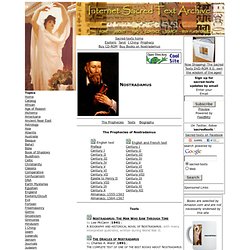

Christianity, A History of the Catholic Church. Knights Templar History. Templars by the Numbers Historical accounts tell that in 1307 when the king of France went after the Order of the Temple, there were approximately 15,000 Templars.
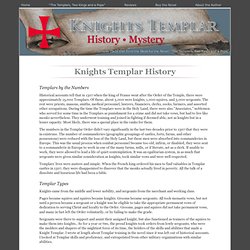
Of these, about 3,000 were knights, 1,000 squires, and 3,000 sergeants. The rest were priests, masons, smiths, medical personnel, lawyers, financiers, clerks, cooks, farmers, and assorted other occupations. During the time the Templars were in the Holy Land, there were also "Associates," noblemen who served for some time in the Templars as punishment for a crime and did not take vows, but had to live like monks nevertheless.
They underwent training and joined in fighting if deemed able, not as knights but in a lesser capacity. The numbers in the Templar Order didn’t vary significantly in the last two decades prior to 1307 that they were in existence. Templars’ lives were austere and simple. Knights Templar History. Knights Templar History Medieval Knights Templar History In 1119 the Poor Fellow-soldiers of Christ and the Temple of Solomon, known by the more popular name of the Knights Templar, were formed in Jerusalem, shortly after the First Crusade ended with the capture of that city.
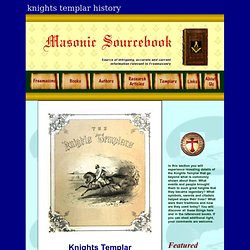
Sources from those times gave this initial date as 1118 or 1119 or 1120 due to use of different calendars and records, with the middle date now being generally accepted.The celebrated purpose of the Knights Templar was to protect the Christian pilgrims now streaming into the Holy Land, because the Islamic Saracens who had held the land in prior years were still roaming the countryside and preying on the pilgrims. --Charles G. Addison In 1129 first Grand Master Hugh de Payens attended the Council of Troyes that was convened by Pope Honorius II in France. Templarhistory.com. Ancient Sanskrit Online: Series Introduction. By Ancient Sanskrit we mean the oldest known form of Sanskrit.
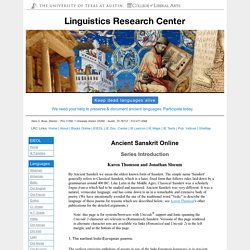
The simple name 'Sanskrit' generally refers to Classical Sanskrit, which is a later, fixed form that follows rules laid down by a grammarian around 400 BC. Like Latin in the Middle Ages, Classical Sanskrit was a scholarly lingua franca which had to be studied and mastered. Ancient Sanskrit was very different. It was a natural, vernacular language, and has come down to us in a remarkable and extensive body of poetry. (We have intentionally avoided the use of the traditional word "Vedic" to describe the language of these poems for reasons which are described below; see Karen Thomson's other publications for the detailed arguments.) Note: this page is for systems/browsers with Unicode® support and fonts spanning the Unicode 3 character set relevant to (Romanized) Sanskrit. 1. The earliest surviving anthology of poems in any of the Indo-European languages is in Ancient Sanskrit. 2. 2.1. 2.2. 3. 4. 5. 6. 7.
Sanskrit. Sanskrit (/ˈsænskrɪt/; संस्कृतम् saṃskṛtam [səmskr̩t̪əm], originally संस्कृता वाक् saṃskṛtā vāk, "refined speech") is the primary liturgical language of Hinduism, a philosophical language in Hinduism, Buddhism, and Jainism, and a scholarly literary language that was in use as a lingua franca in the Indian cultural zone.
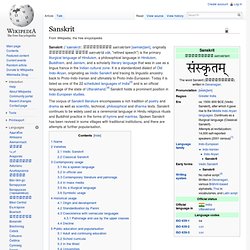
It is a standardized dialect of Old Indo-Aryan, originating as Vedic Sanskrit and tracing its linguistic ancestry back to Proto-Indo-Iranian and ultimately to Proto-Indo-European. Today it is listed as one of the 22 scheduled languages of India[3] and is an official language of the state of Uttarakhand.[4] Sanskrit holds a prominent position in Indo-European studies. The corpus of Sanskrit literature encompasses a rich tradition of poetry and drama as well as scientific, technical, philosophical and dharma texts. Sanskrit continues to be widely used as a ceremonial language in Hindu religious rituals and Buddhist practice in the forms of hymns and mantras. Nag Hammadi Library. The Nag Hammadi Library, a collection of thirteen ancient books (called "codices") containing over fifty texts, was discovered in upper Egypt in 1945.
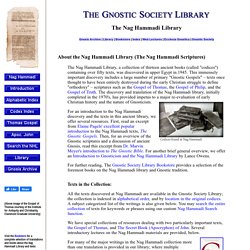
This immensely important discovery includes a large number of primary "Gnostic Gospels" – texts once thought to have been entirely destroyed during the early Christian struggle to define "orthodoxy" – scriptures such as the Gospel of Thomas, the Gospel of Philip, and the Gospel of Truth. Gnostics, Gnostic Gospels, & Gnosticism. A one-sentence description of Gnosticism: a religion that differentiates the evil god of this world (who is identified with the god of the Old Testament) from a higher more abstract God revealed by Jesus Christ, a religion that regards this world as the creation of a series of evil archons/powers who wish to keep the human soul trapped in an evil physical body, a religion that preaches a hidden wisdom or knowledge only to a select group as necessary for salvation or escape from this world.
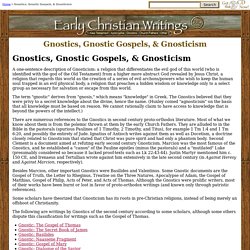
The term "gnostic" derives from "gnosis," which means "knowledge" in Greek. The Gnostics believed that they were privy to a secret knowledge about the divine, hence the name. (Huxley coined "agnosticism" on the basis that all knowledge must be based on reason. We cannot rationally claim to have access to knowledge that is beyond the powers of the intellect.) There are numerous references to the Gnostics in second century proto-orthodox literature. Here are some books about Gnostics and Gnosticism.
MATTHAEUM - Ancient Text Stargate : Lanteans. The Egyptian Book of the Dead Index. Sacred Texts Egypt.

Nostradamus Index. Sacred-texts home Esoteric Tarot I Ching ProphecyBuy CD-ROM Buy Books on Nostradamus.
